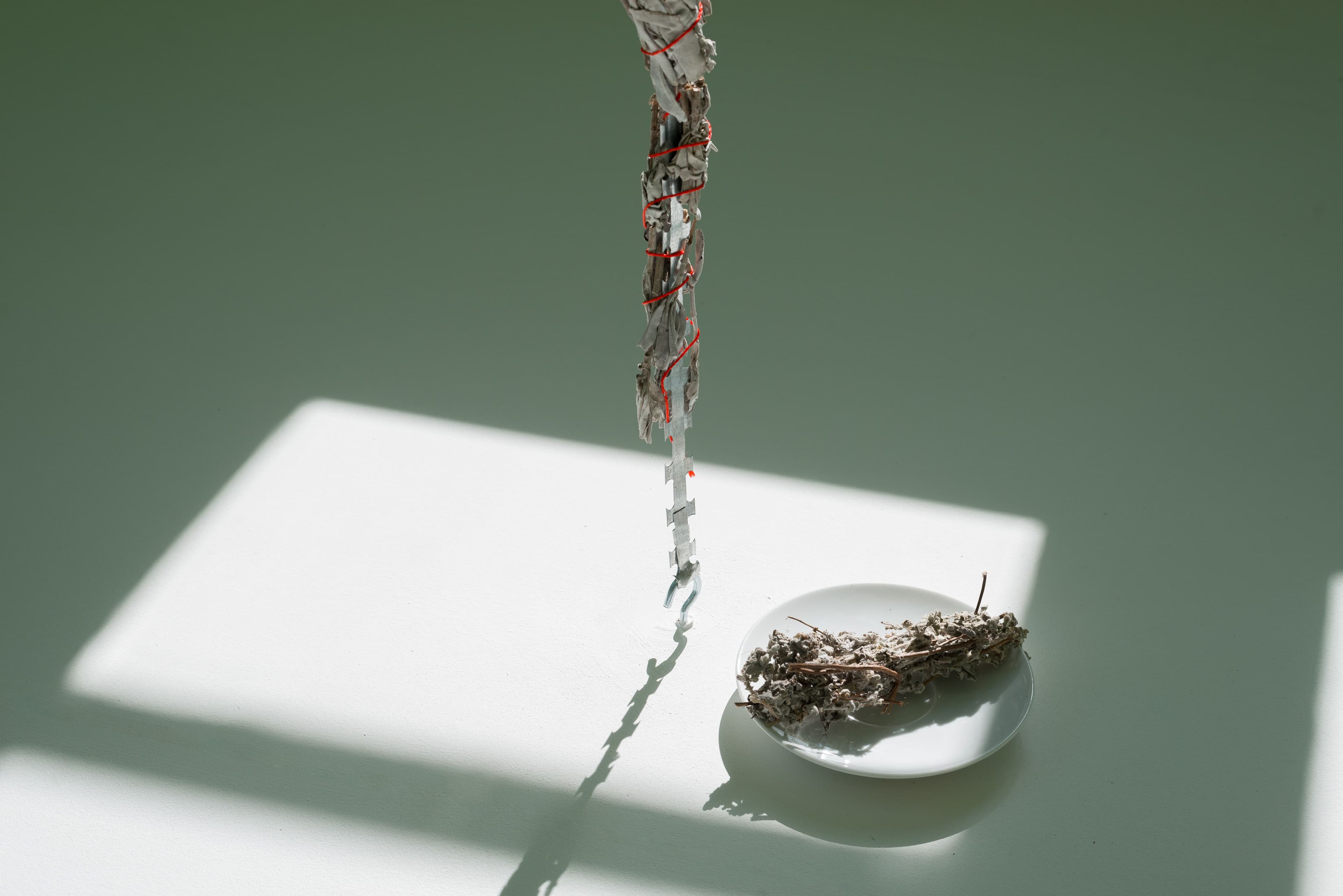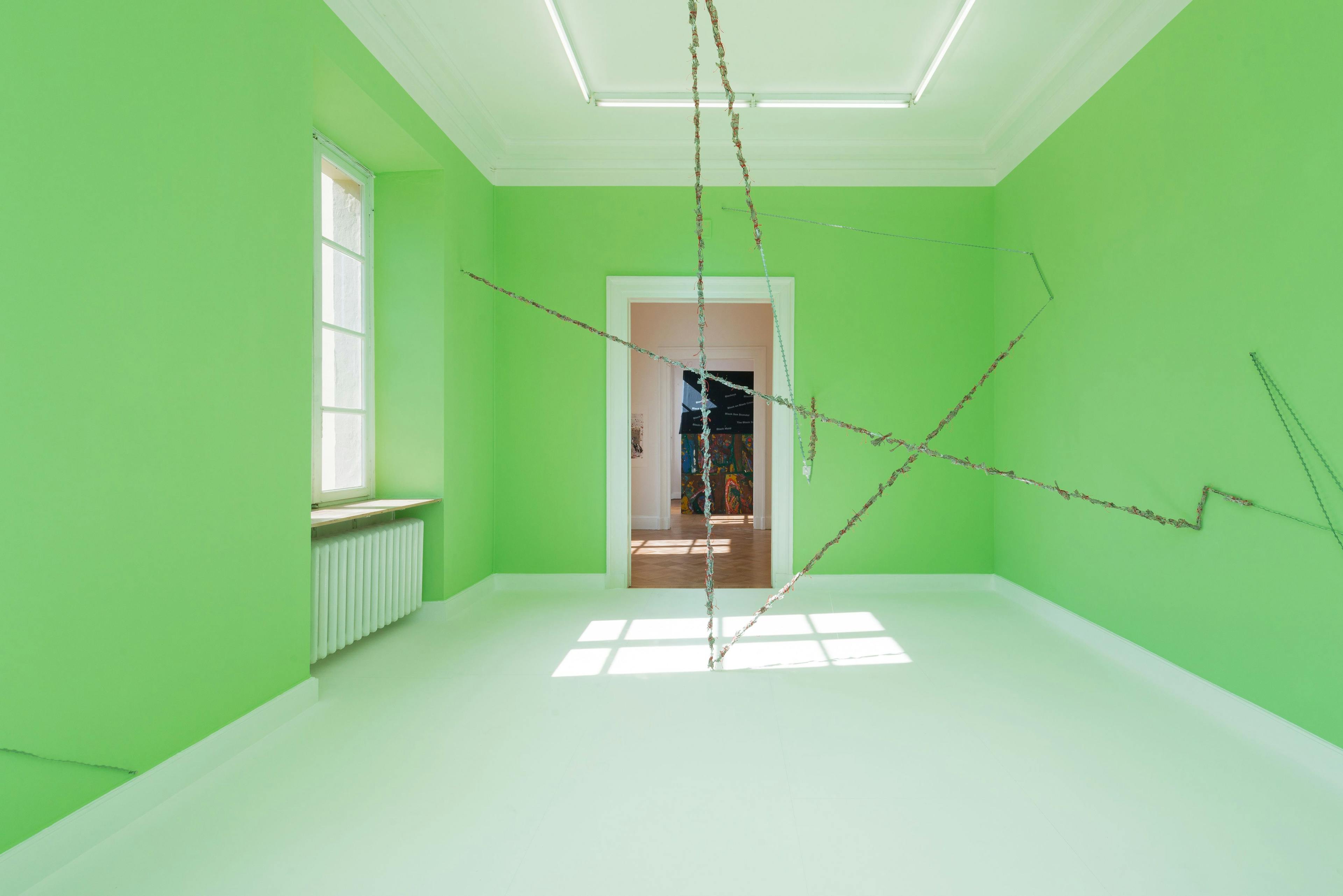The South African artist Lungiswa Gqunta (b. 1990) creates multisensory installations that interrogate the legacies of colonialism and segregation. Her practice often incorporates plants and explores the environments in which they are entangled with human labor and leisure. While Gqunta's work is emblematic of a broader botanical resurgence in contemporary art (Aloi et al. 2019), it exemplifies the particular significance of plants in the art of Africa and the African Diaspora. While we think of plants as rooted to one spot, their global travels and local associations provide a powerful lens for reflecting on histories of forced migration and injustice, but also resilience and community.
The themes of displacement and belonging inspired Gqunta's 2020 installation Benisiya Ndawoni II: Return to the Unfamiliar. The work was composed of razor wire wrapped in sage leaves held together with cotton string (fig. 1). The smell of burning herbs permeated the installation. The taut wire running across the room and up to the ceiling served as a divider that rendered the visitor's movement awkward and intentional. Yet, the light-filled space and green walls created a countervailing mood of serenity, while the use of sage (Salvia officinalis) brought associations with healing and memory.
The installation was created for the exhibition Faculty of Seeing: Thinking With, Through, and by Anton Wilhelm Amo at the Kunstverein, Braunschweig, Germany presented from March 28 to September 13, 2020. Gqunta's title Benisiya Ndawoni, or “Where were you headed to?” in isiXhosa, refers to Amo's migrations. An eighteenth-century philosopher born in West Africa, Amo was taken as a small child to Amsterdam, then Germany in 1707. One of the first persons from Africa to study and teach in a European university, he obtained degrees in law and philosophy and taught at the universities of Halle and Jena. He defended his law thesis on De jure Maurorum in Europa (On the Right of Moors in Europe) and wrote a dissertation on De humanae mentis ἀπαθεία (On the Impassivity of the Human Mind), among other works. In 1748, under circumstances that remain unclear, he returned to West Africa (Menn & Smith 2020).
Gqunta worked on the installation while on an artist residency in Amsterdam, which prompted her to reflect on past and present histories of migration and xenophobia.1 Amo's enigmatic crossings between Africa and Europe evoked contemporary waves of migration fueled by inequality and violence and fraught with danger and hostility. The gaps in our knowledge of Amo's life story took shape in the empty spaces of the installation, while the razor wire alluded to the violence of borders: a disturbing haptic reminder of the vulnerability of the body.
Gqunta's play on the intellect and the senses, reinforced by the smell of sage, mirrored Amo's philosophical career, which explored the relationship between body and mind. Amo wrote that “nothing is in the mind's act of understanding that had not previously been perceived by the senses” (Menn and Smith 2020: 133).2 At the same time, Amo insisted that the faculty of sensing pertained solely to the body and that “the act of understanding” should not be confused with “the business of feeling” (Marshall and Sreedhar 2019: 458). The Enlightenment's focus on the senses as humans' interface with the world generated profound epistemological and ethical questions: How can we access ideas beyond the boundaries of our familiar experience? How can we practice agency if we are the product of our experiences? How can we build a shared understanding if our minds inhabit different experiential worlds?
These questions also preoccupy the artist dealing with historical trauma and memory. Gqunta disrupts the viewer's passive consumption of the artwork by fostering discomfort that follows the visitor home and incites reflection.3 Vision was the privileged sense of the Enlightenment and continues to carry the authority of first-hand observation. But this dominance of vision over the other senses can foster the illusion of false mastery, of distance and separation between the subject and its object. The multisensory nature of Benisiya Ndawoni, and especially its olfactory component, undo this putative distance. Smell assails us, entering our body even before we realize it, carrying a strong link to memory. It is a sense “mired in paradox,” seemingly immediate yet culturally inflected (Drobnick 2006: 1). Previous works by Gqunta were infused with the incendiary smell of petrol, but here the smell of burning herbs recalls the comfort of home, albeit with a lingering tinge of the uncanny and unfamiliar.
The smell infusing the installation is not that of burning sage, but of impepho (Helichrysum petiolare) (fig. 2). The artist burnt impepho in the installation but used sage, which was more widely available in Germany, to wrap painstakingly around the wire. Native to South Africa, impepho is used in the spiritual practice of the amaXhosa—Gqunta's community— and other communities to cleanse space and prepare it for the ancestors. In ritual, the burning of impepho collapses the division between past and present, allowing for communication across time. In the social space of the Western Cape, the smell is associated with traditional healing practices (Philander 2012; Sobiecki 2014).

Given the scarcity of impepho, sage provided a local substitute with far-reaching connotations. Members of the sage or Salvia genus have long histories of medicinal and ritual use in cultures around the world. Sage was considered a potent medicine in Greek and Latin antiquity. In early modern European herbals, (books that listed plants and their medicinal properties), Salvia officinalis is a cure for many ailments that also 'quickneth the senses and memorie' (Gerard 1597). White sage (Salvia apiana) is an important and sacred medicine used by indigenous peoples in North America. It has become so popular that its commodification and wanton harvesting now threaten indigenous communities' access to the plant. Recent medical literature references sage's potential use against diseases that affect cognition and memory.
Gqunta's substitution of sage for her native impepho was both a practical necessity and a powerful instance of cultural translation. Just as English is a lingua franca of global communication, sage has come to serve as transcultural spiritual cleanser, including in acts of protest and symbolic fumigation in art spaces.4 Yet the substitution of sage for impepho does not imply a facile universality. As the example of the overharvested Salvia apiana shows, uprooting plants from their local cultural and ecological contexts carries human and environmental consequences. The use of impepho as burnt offering in the installation, alongside sage, keeps alive the local knowledge, plant lore, and ritual that feed Gqunta's artistic practice. Impepho recreates abroad the familiar smell of home, forging a connection to a foreign space and a historically remote subject.
The sensory interaction of the two plants thus generates aesthetic tension: the installation honors the specificity of local relationships between species and communities (impepho), while striving to communicate across cultures and audiences (sage). As powerful carriers of meaning, in Benisiya Ndawoni plants catalyze the negotiation of Amo's life and its significance across temporal and geographical boundaries. Inescapably local but at the heart of global migrations, connecting us to rituals of home yet evocative of foreign lands, plants in contemporary art enrich our understanding of the present legacies of past displacement and violence: where are we headed to?
References
- Aloi, Giovanni, Caroline Picard, and Lucy Davis (2019) Why Look at Plants? The Botanical Emergence in Contemporary Art. Leiden: Brill Rodopi.
- Drobnick, Jim (2006) Introduction: Olfactocentrism. In The Smell Culture Reader, edited by J. Drobnick. Oxford: Berg, pp. 1–12.
- Gerard, John (1597) The Herball, or, Generall Historie of Plants. Edited by T. Johnson. London.
- Marshall, Eugene and Susanne Sreedhar (2019) Anton Wilhelm Amo.In A New Modern Philosophy: The Inclusive Anthology of Primary Sources, edited by E. Marshall and S. Sreedhar. New York: Routledge, pp. 453–61.
- Menn, Stephen and Justin E. H. Smith (2020) Anton Wilhelm Amo's Philosophical Dissertations on Mind and Body. New York: Oxford University Press.
- Philander, Lisa E. (2012) Hunting Knowledge and Gathering Herbs: Rastafari Bush Doctors in the Western Cape, South Africa. Journal of Ethnobiology 32: 134–56.
- Sobiecki, Jean-Francois (2014) The Intersection of Culture and Science in South African Traditional Medicine. Indo-Pacific Journal of Phenomenology 14: 1–10.
Footnotes
-
Interview with the artist on December 19, 2020. ↩
-
A strict mind-body dualist, Amo argued that the body could not act directly on the mind, but that the mind’s intention was instrumental to deriving knowledge of the world from our senses. ↩
-
Interview with the artist on December 19, 2020. ↩
-
For example, the burning of sage by demonstrators at the Whitney Museum protesting the vice-chairman's ties to a tear gas manufacturer in December 2018. Accessed 1/16/2021. ↩

